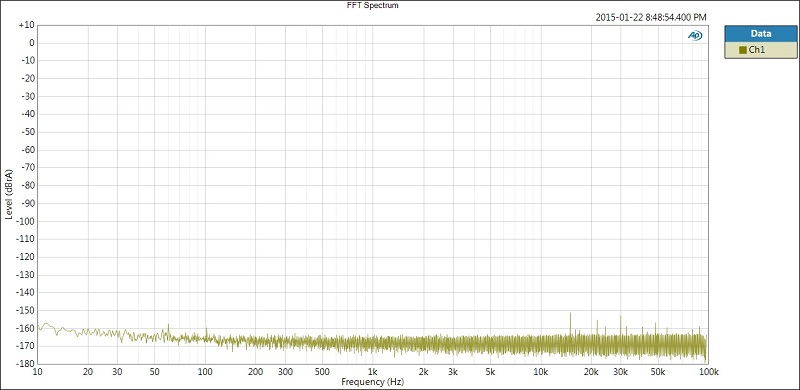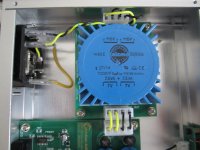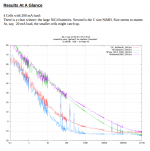... that's a very nice LDO part!
most specs are with Vin =Vo+1V
so recharge batteries when Vin ~ 6.0V or 3.0V / cell
Hi and thanks again. This is a fundamental point.
Speaking of transformers usually secondary voltage comes at 6VAC or 9VAC.
I bought some at 9AC ... i understand now that i am on the very high side 🙁
But i do not know.
I have discovered lately that even clock generators, units very similar to mine, also very very expensive come with SMPS.
This is making me rethink.
I mean for sure when they will arrive i will test the batteries. I bought them already. But a power supply would be so much more convenient.
This will free me completely from the duty of recharging batteries. 🙄
Thanks a lot again. gino
SLA batteries have impedance @1kHz in the hundreds of milliOhms, best paralleled with poplypropylene film cap
Hi and thanks for the very useful information and advice.
I used them with a 10mF cap as a buffer ... but i see now that i should have bypassed the cap with a film one ... good to know.
But they worked very ok ... i saw a nice potential indeed.
In the audio listening, (not RF) you'll find that noise is pretty far down the list in terms of importance, high PSRR is #1 and low impedance is #2.
The small size of the 9V is a plus.
problem is that i do not know the PSRR of the circuit.
I can only provide the cleanest power i can.
thanks again, gino
you seem to be floundering for solutions to perceived problems that may or may not exist.
use a high quality DC/DC converter to feed 6VDC to the LDO from the rectified 9 VAC? I suggest you get a handle on the load current 1st>
use a high quality DC/DC converter to feed 6VDC to the LDO from the rectified 9 VAC? I suggest you get a handle on the load current 1st>
you seem to be floundering for solutions to perceived problems that may or may not exist.
use a high quality DC/DC converter to feed 6VDC to the LDO from the rectified 9 VAC? I suggest you get a handle on the load current 1st>
Hi and thanks again and sorry for being confused and so confusing
I am attaching the stock power supply of the unit ... it is plain ridiculous.
No mains filtering ... poor diodes bridges ... they could have done much much better ... this one i am able to design also myself. And i said all.
I would like to replace everything up to the smoothing caps after the bridges.
And this implies to provide very very very clean DC to the caps before the regulator.
This is the situation ... not nice at all.
Would you live with such basic ps ? i do not think so.
So i need extremely clean DC to supply the caps before the regulator and these are the options:
1) rechargeable batteries
2) a much better first regulation stage with external transformer (it does not fit inside)
3) an external quality smsp with additional regulation and filtering inside the unit
all these options can be much superior to the stock solution.
Unfortunately i cannot see the spectrum of noise at the regulator input ... but i guess it would be not nice at all.
Full of noise also in the audio band ... i am absolutely sure of this.
If you feed the regulator with an almost noiseless DC the sound will be magical ... i am sure of this.
And i will be absolutely done. Because this unit will make any decent pc sound very very good indeed.
I have already many decent dacs laying around just waiting to be fed with a good quality AES/EBU stream
I repeat ... the stock unit is already decent. But it could be even better.
Thanks again, gino
Attachments
Last edited:
well you have a perfect solution 2x18650 series batteries > into a LDO at 5V,
those 2 batteries should last many hours or days before charging.
but then you start flipping around again, try it and then see. either that or build some test equipment to amplify AC noise from DC supplies or youll never be satisfied.
do you have some condition of mental noise ?
those 2 batteries should last many hours or days before charging.
but then you start flipping around again, try it and then see. either that or build some test equipment to amplify AC noise from DC supplies or youll never be satisfied.
do you have some condition of mental noise ?
well you have a perfect solution 2x18650 series batteries > into a LDO at 5V, those 2 batteries should last many hours or days before charging.
Hi and thanks again and this is a very good news. Also the note about duration of a charge. I will try them soon for sure. End of this month they should be here.
If they will be good i would like to integrate the charger in the unit.
Like a switch charge/listening.
In that way i could disconnect them to the grid for listening.
But i will ask again about that.
but then you start flipping around again, try it and then see. either that or build some test equipment to amplify AC noise from DC supplies or youll never be satisfied.
do you have some condition of mental noise ?
let me say one thing straight.
I trust completely instruments and measurements. And in particular in noise spectra.
I do not believe in testing by ear i mean.
If i had a good way to get a noise spectrum at the regulator input i would be sure about the quality of the quality of noise before it.
I have got already important confirmation that the lt1963 behaves poorly at higher freq.
Honestly i do not know how wide this noise spectrum must be.
I see 100kHz as a common value for the upper limit.
Like i would be extremely interested to see the noise spectrum of these batteries.
I have also to add one thing.
I have looked inside very high quality professional clock generators, units that can be considered same "family" of my converter.
They employ i guess with success even SMPS ... and often they also seem coming from the shelf, not proprietary special ones i mean.
My point is that i am still confused a lot about the actual requirements for a power supply for digital devices.
and this is of course a fundamental point.
Someone say that it has not be so noiseless in the end ... just a decent one would suffice.
I prefer the less noise possible ... on principle.
I will let you know how the batteries will behave.
I am crossing my fingers ... i am very very curious.
Thanks a lot again, gino
Last edited:
I trust completely instruments and measurements. And in particular in noise spectra.
1st confirm and then trust
BTW you have a thread started about trust, where I stated that digital circuits have an inherent noise threshold, such that the DC supply / ground rails of saturating logic families are not clean at all, they create what's called "digital hash" or self noise. These noise levls are in the 10's of mV if not higher depending on Rds (on), Vcc, and PCB design. Now think about that.... its not going to make any difference providing a ultra clean DC in the uV.
IMO you trust the wrong folks, the sellers of expensive gear and the self appointed gurus who talk circular nonsense. I think youre a audio marketing dream target. 'there is a well known saying in engineering "its buried in the noise". You need instruments to convince yourself.
1st confirm and then trust
BTW you have a thread started about trust, where I stated that digital circuits have an inherent noise threshold, such that the DC supply / ground rails of saturating logic families are not clean at all, they create what's called "digital hash" or self noise. These noise levls are in the 10's of mV if not higher depending on Rds (on), Vcc, and PCB design. Now think about that.... its not going to make any difference providing a ultra clean DC in the uV.
Hi and thanks a lot and clearly i missed this one.
An internal noise of that absurdly high level ?
that clearly cannot be cured even with some kind of cap bypassing ?
i have seen some chips with a film caps across some terminals.
It is very high indeed.
Some regulators provide DC with just some 10's of uV, 1000 times lower than that.
Sorry but if this is the case how can you explain this noise spectrum ? there is no noise to speak at all. And this is a complete dac.

IMO you trust the wrong folks, the sellers of expensive gear and the self appointed gurus who talk circular nonsense. I think youre a audio marketing dream target.
'there is a well known saying in engineering "its buried in the noise". You need instruments to convince yourself.
i think i have to learn more before starting modding
It could be a very big mistake because the risk to damage all is just around the corner.
In the weekend i will reassemble the unit and stop rambling ... i remember already a quite decent sound after all.
Thanks a lot again, gino
Last edited:
where is the main signal? pass through calibration
Ive seen many PC SA tests where CM noise is ignored, not the case in real world setups. IMO a single 2 tone test is the most useful single plot DAC presentation.
presenting data with out test setup and device setup and operating conditions is useless data.
Ive seen many PC SA tests where CM noise is ignored, not the case in real world setups. IMO a single 2 tone test is the most useful single plot DAC presentation.
presenting data with out test setup and device setup and operating conditions is useless data.
where is the main signal? pass through calibration
Ive seen many PC SA tests where CM noise is ignored, not the case in real world setups.
Hi and actually i do not know much about science
this is the page anyway
exaSound Audio Design > e12 > e12 Measurements
in this same page there is non interesting discussion about galvanic isolation with graphs that show how beneficial it is.
Very interesting.
i wonder how could it be possible to add galvanic isolation to a dac.
IMO a single 2 tone test is the most useful single plot DAC presentation.
presenting data with out test setup and device setup and operating conditions is useless data
sorry but in this way you add distortion to noise ?
I admit my ignorance. I do not know the basics.
Thanks again, gino
Gerhard Hoffman is a regular forum contributor, did some analysis of noise in batteries -- this chart sums it up. The entire paper can be found here: http://www.hoffmann-hochfrequenz.de/downloads/NoiseMeasurementsOnChemicalBatteries.pdf
Me, I am using a pair of 18650's to power one of Jan Didden's Silent Switcher's. This gives me +/- 15V at 150mA
Me, I am using a pair of 18650's to power one of Jan Didden's Silent Switcher's. This gives me +/- 15V at 150mA
Attachments
- Home
- Amplifiers
- Power Supplies
- Best option for 9V rechargeable batteries

